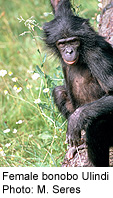
WEDNESDAY, June 13 (HealthDay News) — Scientists who have completed the genome of the bonobo say their research will provide insights into the species’ evolutionary relationships with other great apes and with humans.
The bonobo is the last of the great apes to have its genome sequenced. Other great apes include the chimpanzee, orangutan and gorilla.
Bonobos and chimpanzees are the closest living relatives of humans. But in contrast to the more aggressive chimpanzees, bonobos are known for their peaceful, playful behavior.
The bonobo genome was sequenced from a female named Ulindi who lives at the Leipzig zoo in Germany. The results show that bonobos and chimpanzees differ genetically by about 0.4 percent, while both bonobos and chimpanzees differ from humans by about 1.3 percent.
The study, by Kay Prufer and colleagues at the Max Planck Institute for Evolutionary Anthropology in Leipzig, is published in the June 13 online edition of the journal Nature.
Bonobo and chimpanzee territories in central Africa are separated only by the Congo River. It’s been theorized that the formation of the river separated the ancestors of chimpanzees and bonobos, leading to distinct species. This hypothesis is supported by a comparison of the bonobo and chimpanzee genomes, which shows an apparent clean split and no subsequent interbreeding.
While the average genomes of bonobos and chimpanzees are equally distant from the human genome, humans are closer to bonobos in some regions and closer to chimpanzees in others.
Further research will determine whether these genome regions influence the behavioral differences and similarities between humans, chimpanzees and bonobos, the study authors said.
More information
The Great Ape Trust has more about bonobos.

